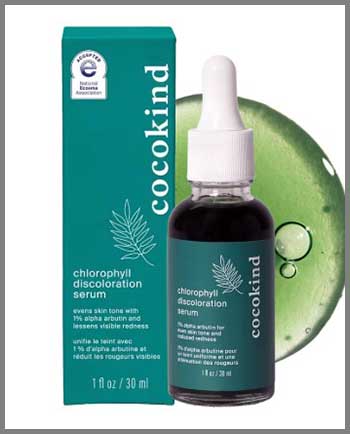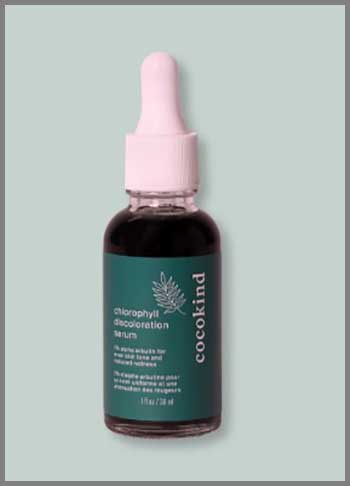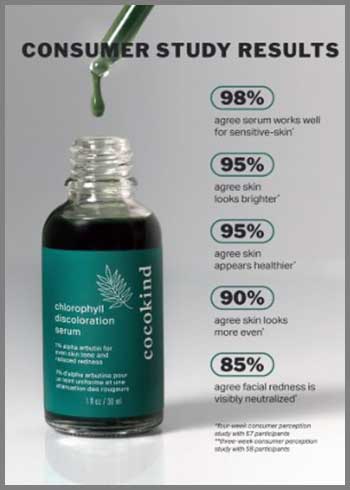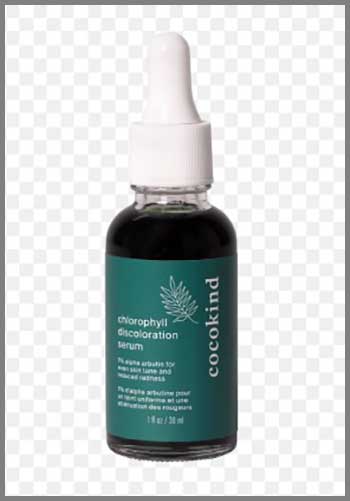I’m not one to chase every skincare trend, but when I heard about Cocokind’s Chlorophyll Discoloration Serum, I couldn’t resist. If you’re battling dark spots, uneven tone, or redness like me, this vegan, sensitive skin-friendly gem is worth your attention.
With 1% alpha-arbutin, chlorophyll, and licorice root, it promises to fade discoloration without irritation. Trust me, it’s a game-changer for a radiant, even complexion. Grab it now and thank me later—your skin deserves this kind of love.
My Journey With Cocokind’s Chlorophyll Discoloration Serum

Let me take you back to when I first spotted those stubborn dark spots creeping up on my cheeks. Years of sun exposure and a few acne scars had left my skin looking like a patchwork quilt. I was desperate for something gentle yet effective, especially since my sensitive skin throws a tantrum at the slightest hint of harsh ingredients.
Enter Cocokind’s Chlorophyll Discoloration Serum. I was intrigued by its plant-powered formula—1% alpha-arbutin to tackle pigmentation, chlorophyll to calm redness, and licorice root to boost brightness. Plus, it’s vegan, cruelty-free, and free of fragrances or essential oils. Sold.
The first night, I applied a single drop after cleansing, as directed. The gel texture felt light, almost like a cooling hug for my skin. It absorbed quickly without leaving a sticky residue, which is a big win for me—I hate that tacky feeling some serums leave behind.
By morning, I didn’t notice a dramatic change, but my skin felt hydrated and calm, no redness in sight. After a week, I started seeing subtle improvements. My post-acne marks looked less angry, and my complexion seemed more even. By the end of a month, I was hooked.
Those stubborn dark spots? Fading. My skin tone? Smoother and brighter. Even on no-makeup days, I felt confident enough to skip foundation, thanks to the serum’s radiance-boosting magic.
What I love most is how it fits into my routine. I use it twice daily, morning and night, and it layers beautifully with my moisturizer. It’s gentle enough that I haven’t experienced any irritation, even when pairing it with other actives like retinol.
This serum has become my ride-or-die, and I’m not alone—friends have noticed my glow and asked for my secret. Spoiler: it’s this little green bottle.
Also read: My Thoughts on Cindy Crawford Melon Serum.
Pros Of Cocokind’s Chlorophyll Discoloration Serum

- Gentle Yet Effective Formula
My sensitive skin and I have been through some rough patches with harsh brightening serums, but Cocokind’s formula is a breath of fresh air. The 1% alpha-arbutin works wonders on dark spots and UV damage without the sting or peeling you might get from stronger ingredients like hydroquinone. It’s a slow-and-steady kind of progress, but after 28 days, I saw real results—my post-blemish marks were noticeably lighter. The addition of panthenol soothes and hydrates, leaving my skin feeling plump and happy. If you’re wary of aggressive treatments, this is your safe bet.
- Vegan and Cruelty-Free
I’m all about aligning my skincare with my values, and Cocokind nails it here. Unlike snail mucin-based products, which are all the rage but not exactly cruelty-free, this serum is 100% vegan. It delivers the same glowy, even-toned benefits without harming any critters. Knowing I’m supporting a brand that prioritizes sustainability and ethics makes me feel good about every drop I apply. You get radiant skin and a clear conscience—what’s not to love?
- Redness-Reducing Power
If your skin gets red and blotchy like mine does, the chlorophyll in this serum is a lifesaver. It’s like a green-tinted primer, but better, because it’s packed with antioxidants that calm irritation and give your complexion a radiant boost. I’ve noticed a huge difference on days when I’m flushed from stress or sun exposure. My cheeks look less like tomatoes and more like, well, normal skin. It’s especially great for no-makeup days when you want to even things out naturally.
- Lightweight and Non-Sticky
Nobody wants a serum that feels like glue on their face. This one’s gel texture is lightweight and sinks in fast, leaving no trace behind. I can layer it under moisturizer or sunscreen without pilling or feeling heavy. Even in humid weather, it doesn’t make my skin feel suffocated. It’s a dream for anyone who craves hydration without the greasy aftertaste.
Cons Of Cocokind’s Chlorophyll Discoloration Serum

- Patience Is Key
Let’s be real: this serum isn’t a magic wand. While I saw subtle changes after a week, it took a full month of consistent use to notice significant fading of my dark spots. If you’re expecting overnight miracles, you might feel frustrated. Alpha-arbutin is gentle, which is great for sensitive skin, but it’s not as fast-acting as harsher brighteners. Stick with it, and you’ll see results, but you’ve got to commit to the 28-day journey.
- Small Bottle Size
At 1 fl oz, the bottle is standard for serums, but I wish it came in a larger size. Using it twice daily, I go through it in about two months. For the price, it’s reasonable, but if you’re on a budget, the frequent repurchasing might sting a bit. I’d love a jumbo version for those of us who’ve made it a staple in our routines.
- Slight Green Tint
The chlorophyll gives the serum a faint green hue, which worried me at first—would I look like Shrek? Thankfully, it doesn’t leave a tint on your skin once it absorbs. However, if you’re heavy-handed with application, you might notice a temporary greenish cast before it sinks in. It’s not a dealbreaker, but it’s something to be mindful of, especially if you’re applying it in a rush.
Comparison With Other Brands
- The Ordinary’s Alpha Arbutin 2% + HA
I’ve tried The Ordinary’s Alpha Arbutin 2% + HA, which is another budget-friendly option for tackling discoloration. It’s got a higher concentration of alpha-arbutin, so it works a bit faster on dark spots. However, it lacks the soothing, redness-reducing ingredients like chlorophyll and panthenol that make Cocokind’s serum so gentle. I found The Ordinary’s formula a tad sticky, and it irritated my sensitive skin when paired with retinol. If you’ve got tougher skin and want quick results, The Ordinary might edge out, but for a well-rounded, irritation-free experience, Cocokind wins.
- Paula’s Choice Skin Perfecting 2% BHA Liquid Exfoliant
Paula’s Choice BHA exfoliant is a cult favorite for evening skin tone, and I’ve used it to tackle texture and discoloration. It’s great for unclogging pores and smoothing skin, but it’s not specifically designed for hyperpigmentation like Cocokind’s serum. The salicylic acid can be drying, especially for sensitive skin, and it doesn’t offer the calming benefits of chlorophyll or licorice root. I still love it for exfoliation, but for targeted spot-fading, Cocokind’s serum is more effective and gentler.
- Drunk Elephant’s C-Firma Day Serum
Drunk Elephant’s C-Firma is a vitamin C serum that promises to brighten and even skin tone, and I gave it a whirl before discovering Cocokind. It’s packed with antioxidants, but the high vitamin C concentration irritated my skin, especially when used daily. It’s also pricier than Cocokind’s serum, and the pump packaging can be finicky. While it’s great for overall radiance, it doesn’t target dark spots as precisely as alpha-arbutin does. For sensitive skin and budget-conscious folks, Cocokind’s serum is the better pick.
Maintenance Tips For Using Cocokind’s Chlorophyll Discoloration Serum

- Stick to a Consistent Routine
To get the most out of this serum, you’ve got to use it daily, morning and/or night. I apply it after cleansing and toning, before my moisturizer. Consistency is everything—skipping days won’t give you the results you’re after. Set a reminder on your phone if you’re forgetful like me. After 28 days, you’ll start seeing those dark spots fade, but keep going to maintain that glow.
- Layer It Correctly
If you’re using other serums, like Cocokind’s Ceramide Barrier Serum, apply the Chlorophyll Discoloration Serum first. Its lightweight texture makes it a great base for layering. Follow up with a moisturizer to lock in the benefits, and don’t skip sunscreen in the morning—UV exposure can undo all your hard work. I love pairing it with a broad-spectrum SPF 30 or higher to protect my skin.
Read More: My Thoughts on Lancôme’s Advanced Génifique Serum.
- Patch Test First
Even though it’s formulated for sensitive skin, everyone’s skin is different. I always patch-test new products on my inner arm before slathering them on my face. Apply a small amount and wait 24 hours to check for irritation. This serum played nice with my skin, but it’s better to be safe than sorry, especially if you’re prone to reactions.
- Use the Right Amount
One drop is all you need for your whole face. I learned this the hard way after over-applying and noticing that faint green tint I mentioned earlier. A little goes a long way, so don’t waste product. Spread it evenly, focusing on areas with discoloration, and let it absorb fully before moving on to the next step in your routine.
- Store It Properly
To keep the serum effective, store it in a cool, dry place away from direct sunlight. I keep mine in a drawer to protect the ingredients from degrading. The glass bottle feels luxe, but it’s also fragile, so handle it with care. Proper storage ensures you get every last drop of its spot-fading goodness.
Frequently Asked Questions (Faq)
Yes, you can pair it with a vitamin C serum, like Cocokind’s Vitamin C Glow Serum. I apply the Chlorophyll Discoloration Serum first, followed by vitamin C, to target both discoloration and overall brightness. Since everyone’s skin is unique, patch-test the combo to ensure no irritation. The two work well together for a radiant, even complexion.
For best results, use Cocokind’s Chlorophyll Discoloration Serum daily, morning and/or night. I’ve found twice daily works wonders for fading dark spots. Consistency is key—use it for at least 28 days to see noticeable changes. If your skin is super sensitive, start with once daily and build up.
I’ve tried Cocokind’s Vitamin C Glow Serum, and it’s a solid choice for brightening. With ascorbyl glucoside and azelaic acid, it gives a subtle glow and helps with uneven tone. It’s gentler than high-potency vitamin C serums, making it great for sensitive skin. Pairing it with the Chlorophyll Serum amps up the results.
Absolutely, but proceed with caution. I use this serum in the morning and retinol at night to avoid potential irritation. If you want to use them together, apply the Chlorophyll Serum first, wait a few minutes, then apply retinol. Patch-test and start slowly, especially if your skin is sensitive.
Final Thoughts
After months of using Cocokind’s Chlorophyll Discoloration Serum, I’m sold. It’s gentle, effective, and aligns with my values as a vegan, cruelty-free product. If you’re tired of dark spots stealing your glow, this serum is your ticket to an even, radiant complexion. Don’t wait—add it to your routine and watch your skin transform. You won’t regret it.
